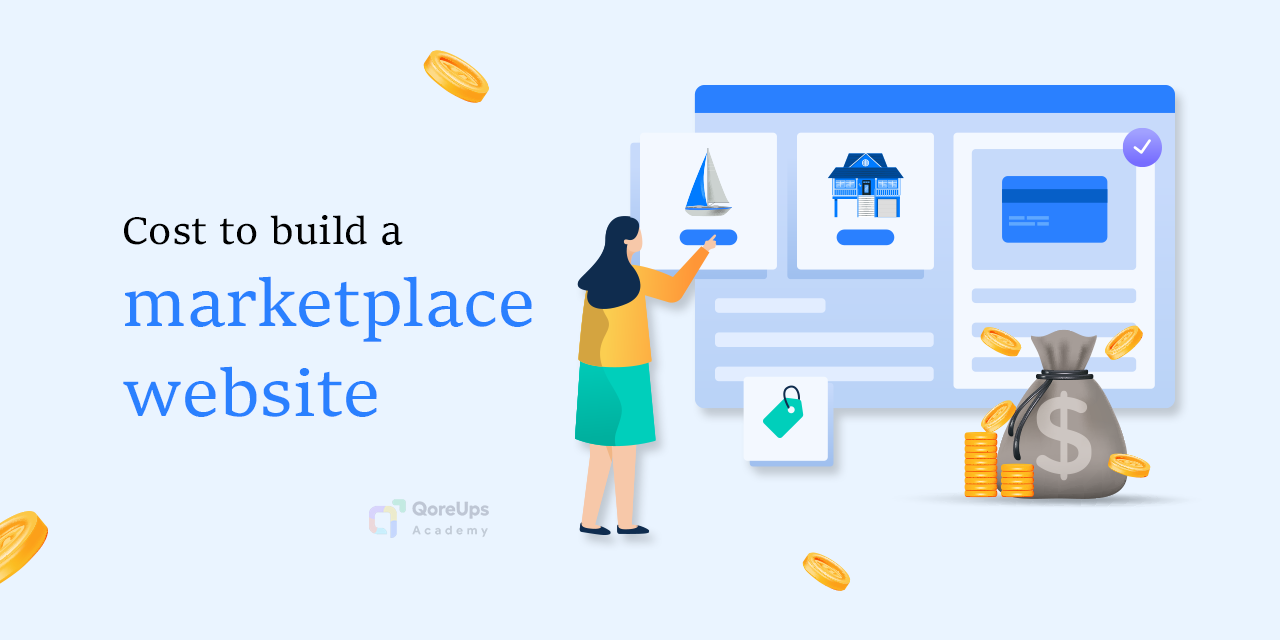“Budget & Cost” these 2 terms that fear most entrepreneurs.
When building a marketplace website, these fears can be especially pronounced.
The digital marketplace arena is incredibly competitive, and creating a successful platform requires careful financial planning.
Understanding the costs involved can help alleviate some of that anxiety and allow you to focus on building a thriving business.
In 2024, with technological advancements and shifting market dynamics, the cost to build a marketplace website can vary widely based on several factors.
Everyone fears whether the initial investment will return a profit. So,
What Is A Marketplace Website?
A marketplace website is an online platform that connects buyers and sellers to exchange goods or services.
Think of it as a virtual online marketplace where businesses or individuals can showcase their offerings while users browse, compare, and make purchases.
Key Features of a Marketplace Website:
- User Profiles: Separate dashboards for buyers and sellers.
- Product Listings: Easy to upload and manage listings.
- Search and Filters: Simplifies finding relevant items.
- Secure Payment Gateway: Ensures smooth and safe transactions.
- Reviews and Ratings: Builds trust and credibility.
Is Building A Marketplace Website Profitable In 2025?
The marketplace industry in the United States is on a trajectory of continuous growth.
Let’s take a closer look at the key statistics and insights:
- User Growth (2023-2027):
- Increase in Users: The number of marketplace website users is expected to grow by 15.2 million.
- Growth Rate: This represents a growth rate of 5.53%.
- Total Users by 2027: The total number of marketplace website users is projected to reach 289.91 million by 2027.
- Historical Growth:
- The marketplace website has been expanding consistently for 9 consecutive years.
- Market Trends:
- Online Marketplaces’ Role: For established commerce giants, more than 40% of their products are sold through online marketplaces.
- New Companies’ Reliance: Newer companies often rely entirely on online marketplaces for sales, sometimes reaching sales figures exceeding a billion dollars.
These statistics and trends highlight the robust and growing nature of the marketplace industry in the U.S., driven by both increased user engagement and the strategic advantages offered by online marketplaces.
Key Components Affect Cost To Build A Marketplace Website
Building an online marketplace can be a rewarding venture but also involves significant investment.
The total cost to build a marketplace website can vary widely based on several key factors:
Complexity of Features: Basic vs. Advanced
Basic marketplaces with simple buy/sell functionalities are less expensive to develop than those with advanced features such as auctions, subscriptions, or complex search algorithms.
More features necessitate more development work, increasing costs.
Technology Stack: Open-Source vs. Proprietary
The choice of technology stack—including programming languages, databases, and hosting services—impacts costs.
Using open-source technologies can be more cost-effective compared to proprietary, licensed software.
Design and User Experience (UX): Basic Templates vs. Custom Design
Utilizing basic templates is cheaper, but custom-designed interfaces that enhance user experience will increase the budget.
High-quality UX design can attract and retain users but requires additional investment.
Project Scope: MVP vs. Full Vision
Developing a Minimum Viable Product (MVP) with core functions is more affordable than building the full envisioned product from the outset.
Starting with an MVP platform allows for initial testing and feedback, with the option to scale up later.
However, ongoing costs for hosting, maintenance, and future upgrades must be considered.
Building scalability and flexibility into the initial design can help mitigate long-term costs.
Development Team: Experienced Teams vs. Freelancers
The cost is also influenced by the team you hire.
Experienced, specialized teams ensure higher quality but are more expensive compared to hiring freelancers or less experienced developers.
Balancing cost and quality is crucial for the success of your marketplace.
In summary, the overall costs of building an online marketplace are influenced by the following factors:
- Requirements: Complexity and range of features.
- Technology: Choice between open-source and proprietary technologies.
- Design: Level of customization and user experience.
- Scope: Whether to start with an MVP or a complete product.
- Development Team: The expertise and cost of the development team.
Each of these factors must be carefully considered to balance budget and functionality effectively.
Now let’s see the breakdown of the cost to build a marketplace website.
How To Build A Marketplace Website?
Creating a marketplace website requires thorough preparation and implementation.
Let’s see a step-by-step guide to help you create a successful marketplace website:
Research and Planning
Determine your specialty and target market first.
Analyze competitors to understand their strengths and weaknesses, and conduct market research to identify gaps you can fill.
Create a roadmap outlining your goals, budget, and timeline for the project.
Choose a Business Model
Decide how your platform will generate revenue.
Common models include commissions on transactions, subscription fees, listing fees, or advertisements.
Ensure the model aligns with your target audience and business goals.
Select a Development Method
Depending on your budget and requirements, you can choose custom development, open-source platforms, or SaaS marketplace builders (such as QMarket).
Custom development offers full flexibility but is costly, while SaaS platforms are faster and more affordable.
Purchase a Domain and Hosting
Make sure your domain name is memorable and accurately reflects your brand.
The domain you choose for your marketplace website must reflect your brand and be easy to remember.
Choose a hosting provider capable of handling anticipated traffic, ensuring scalability and security.
Design and Develop
Concentrate on developing an interface that is easy to use and has straightforward navigation.
Include essential features such as user profiles, product or service listings, secure payment options, and review systems.
Ensure your website is responsive and mobile-friendly.
Test and Launch
Make sure your website is free of errors, security flaws, and usability problems before releasing.
To get input and improve the platform, do a soft launch with a small audience.
Market and Scale
Promote your marketplace through SEO, social media, and paid advertising.
Engage users with quality content and community-building strategies.
Over time, introduce new features and expand your platform to new regions or markets.
By following these steps, you can create a robust and competitive marketplace website tailored to your business needs.

Average Cost Of Creating Marketplace Website
To create a marketplace website in 2024 involves a multi-faceted process with costs that vary significantly based on your approach and the specifics of your project.
Let’s see the detailed cost breakdown for each step involved in creating a marketplace website:
Market Research and Planning
Scope:
- Target Audience Identification: Detailed profiling of potential users based on demographics, behavior, and needs.
- Competitor Analysis: Comprehensive analysis of existing marketplaces including their features, marketplace pricing, strengths, weaknesses, market positioning, and user feedback.
- Market Gap Analysis: Identifying unmet needs or underserved market segments by examining current offerings and user complaints or requests.
- Feasibility Studies: Assessing the technical and economic viability of the marketplace idea, including potential ROI, technological requirements, and market readiness.
Costs: $1,000 – $10,000
Basic research and simple planning can start at $1,000, escalating to $10,000 for comprehensive studies and detailed planning.
Designing the Business Model
Scope:
- Revenue Stream Identification: Exploring various marketplace revenue model including subscriptions, commissions, listing fees, and advertising.
- Pricing Strategy: Crafting competitive pricing structures that are profitable yet market-sensitive.
- User Acquisition Strategy: Develop strategies for attracting users both organically and via paid channels.
- Retention Strategies: Creating plans to maintain and enhance user engagement and loyalty.
Costs: $2,000 – $15,000
You can design the basic models for as low as $2,000, while more elaborate plans requiring advanced strategies might cost up to $15,000.
Purchasing a Domain and Hosting
Scope:
Domain Strategy: Choosing a relevant, memorable, and SEO-friendly domain name.
Hosting Requirements Planning: Determining the necessary hosting infrastructure based on anticipated traffic and security requirements.
Costs:
- Domain Registration: $10 – $50 per year
- Hosting Services: $20 – $500+ per month, depending on the scale and expected traffic.
Choosing Development Methods For Your Marketplace Website
Scope:
- Custom Development: Deciding on technology stacks and architectures tailored to specific marketplace needs.
- Open Source Solutions: Evaluating and modifying open-source platforms like Magento or WooCommerce.
- Marketplace Builders: Assessing SaaS platforms like QMarket for feature set, customization capabilities, and cost-efficiency.
Costs:
- Developing from scratch can range from $50,000 to $500,000+
- Open source adjustments can vary between $10,000 and $100,000
- Using marketplace builders can range from $50 to $500+ per month.
Launching the Marketplace Website
Scope:
- Quality Assurance (QA): Rigorous testing phases that cover functional testing, performance testing, security audits, and usability to ensure the platform is robust and user-friendly.
- Soft Launch: Initiating a launch with a limited audience to gather real-world data on the marketplace’s performance and user behavior.
- Feedback Incorporation: Refining the platform based on user feedback and initial performance metrics to fine-tune operations before a full launch.
Costs: $5,000 – $20,000
Depending on the depth of testing and initial marketing efforts required.
Promoting and Marketing
Scope:
- SEO and Content Strategy: Development of a content strategy that supports SEO goals, builds brand authority, and engages potential users through valuable content.
- PPC and Social Media Campaigns: Planning and executing paid advertising campaigns across search engines and social media platforms to drive immediate traffic and user registration.
- Community Engagement: Strategies to build and maintain an active community around the marketplace through forums, social media, and events.
Costs: $5,000 – $50,000 per month
Basic to advanced marketing efforts can vary greatly depending on the marketing strategies employed.
Expanding and Scaling
Scope:
- Scaling Infrastructure: Implementing more robust server solutions, considering cloud services for flexibility, and ensuring the infrastructure can handle increased loads without compromising performance.
- Feature Upgrades: Prioritizing and developing new features based on user feedback, market trends, and technological advances to keep the platform competitive and relevant.
- Global Expansion: Preparing for multi-regional scalability, including localization, international payment gateways, and global compliance considerations.
Costs: $10,000 – $200,000 annually
Costs will depend on the extent of scaling and expansion desired.

Finally,
The cost to build a marketplace website in 2024 can range from a few thousand dollars to several hundred thousand dollars, depending on the complexity and scale of your project.
By understanding the cost breakdown for each step, you can better plan your budget and ensure that each phase of your marketplace development is well-funded and aligned with your business objectives.
Proper planning and investment in each stage will ultimately contribute to the success and sustainability of your marketplace platform.






